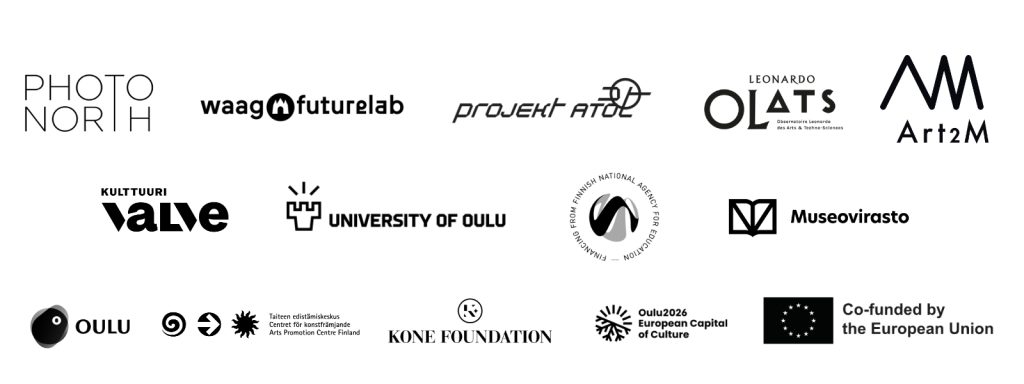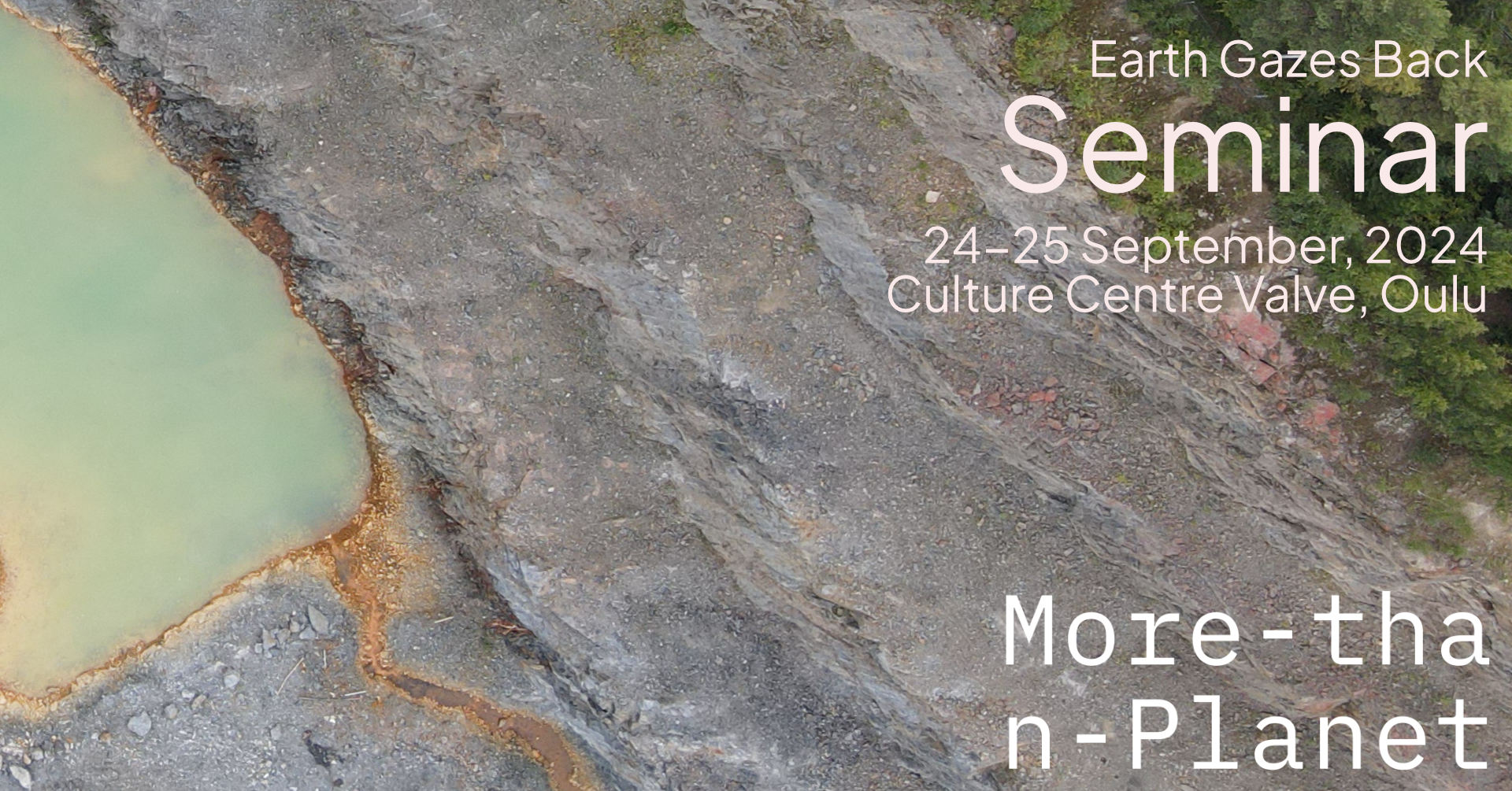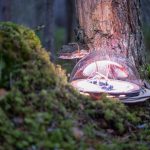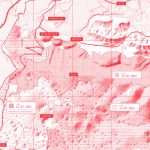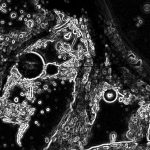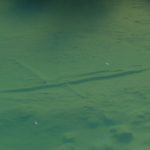Photo North’s More-than-Planet: Earth Gazes Back Seminar and Photo Exhibition Opening will take place on 24-25 September 2024 at Valve Cultural Centre, Oulu.
How can we adapt to the changes that are already happening? How is the planet and its bioregions, biomes, and inhabitants sensing, seeing, and reacting to us? How can we prepare for those changes that are likely to come? What is the role of local and other-than-human knowledge, on one hand, and information acquired from space, the depths of Earth, and through satellites and remote sensing, on the other, in describing our hybrid landscapes and lifeforms?
Photo North’s Earth Gazes Back seminar, publication, and accompanying exhibition invite us to delve into the urgent situation in our environment, explore where we are now, and consider the possibilities for navigating the unknown futures through the observations of artists, local people, and researchers. Developing environmental literacy—our capacity to understand the environment and our part in it—happens through creating new planetary imaginaries for our processes and environments, bioregions, and biomes, from microbes to humans and at the planetary level here on Earth and on other planets and celestial objects.
Earth Gazes Back takes us to space, near space, and the surface of planets with satellites, Mars rovers, and earth-observation applications and tools. It brings us close to the ground with UAVs (Unmanned Aerial Vehicles), drones, cameras, microscopes, and environmental sensory data. The projects, artworks, and presentations in this seminar cover the sphere where life as we know it exists, from the depths of Earth’s bedrock to the Kármán line—the border between space and atmosphere—and on to Mars and back.
To react accordingly to the environmental urgency, we need to see, observe, and understand. From that understanding, we can find relevant questions for the next steps and actions. What new perspectives, knowledge, and novel solutions can we imagine in an era of accelerating environmental change?
The More-than-Planet EU project builds capacity for a richer planetary image and aims to develop environmental literacy for everyone—artists, researchers, and citizens.
______
TUESDAY September 24th 2024
Valvesali Hall, Cultural Centre Valve, Hallituskatu 7, 90100 Oulu, 178 seats
10:00-17:15
Day 1. Eyes on sky and ground
On the first day, there will be presentations and talks ranging from planetary imaginaries and the ways we and other-than-human life see, sense and observe our surroundings through man-made technology. How do we build knowledge for better understanding and planning our future actions? During the day, we dive into earth-observation, the role of the arts, different forest intelligences, and the use of drones, satellites and machine-made images.
10:00-10:20 Earth Gazes Back by Antti Tenetz, Project Manager, More-than-Planet, Photo North – Northern Photographic Centre
10:20-10:35 Oulu2026 by Henri Turunen, Executive Producer, Oulu2026 – European Capital of Culture
Through Cultural Climate Change the aim of the Oulu2026 project is to create and bring culture, wellbeing, and vitality to the Northern Region. The capitals of culture have been named since 1985 and are funded by the Creative Europe Programme. The nomination emphasizes the diversity of European cultures and enhances cultural exchange throughout Europe.
10:35-11:00 On a Journey in Space on a Beautiful Planet by Jaan Praks, Associate Professor, Department of Electronics and Nanoengineering, Aalto University
Earth is a beautiful planet, but seldom do we take time to look at the beauty of this space marble from afar. The Blue Marble, with its exceptionally dynamic atmosphere and biosphere, is a wonder. Planetary processes are interlinked with the developing biosphere, natural catastrophes, and lucky coincidences that have shaped the environment we know today. Let’s expand our perception with modern technology and science, harnessing the power of satellites and other advanced tools to gain a broader understanding. By observing Earth from space, we can distort the time scales and appreciate the intricate patterns and changes that occur over years, decades, and millenia. From the swirling clouds and vast oceans to the sprawling forests and desert landscapes, we see unique beauty at every level. This planet is precious, a rare gem in the vastness of space, and the only place where advanced life is possible within the reach of our foreseeable technology. Life on Earth is a wonder, a delicate balance of ecosystems and biodiversity that sustains us all. Preserving this environment is not just a choice but the only option for our species if we wish to continue thriving on this remarkable planet. By understanding and protecting our home, we honor the miracle of life that exists here and ensure a future for generations to come.
11:00–11:35 Another Earth: Philosophy of Planetary Habitability by Lukaš Likavčan, philosopher
The narrative arc of the talk is organised around two key concepts: astronomical concept of the planet and planetary habitability. While the first concept prompts us to align our cultural conceptualizations of the Earth with its astronomical theorizations, the second navigates our practical interventions towards modes of inhabiting the Earth that presuppose as the primary unit of care life as such, in all its terrestrial or non-terrestrial permutations. While presenting these concepts, the talk will drawfrom resources including exoplanet science, astrobiology, or artistic research.
11:35-12:00 Can We Imagine a Bird’s Eye View? How Contemporary Photography Makes Visible the Relationship Between Humans and the Rest of Nature by Anna-Kaisa Rastenberger, Director, Finnish Museum of Photography
Anna-Kaisa Rastenberger will discuss whether contemporary photography can help us to understand the dimensions of the environmental crisis. With timely examples Rastenberger will discuss the ways in which contemporary photography makes visible the relationship between humans and the rest of nature. For more than 180 years now, the camera has been an ally and a mechanical tool of the human eye. It has both provided information and isolated humans from the rest of nature. It has turned nature into an image. The camera’s optics mimic the structure of the human eye. The camera has been used to gather information about nature, to classify species and to take pictures of nature. And yet the crisis around us and the accelerating disappearance of other species is almost invisible. Rastenberger also asks how the photographic institution can be an activist in an era of climate crisis?
12:00–13:00 LUNCH BREAK
13:00–13:25 The Ability to Sense Remotely Is Not Given – A Vector Through Arts Research by Marko Peljhan, Artist Talk
The story of Marko Peljhan’s involvement with unmanned technologies, remote sensing, and a strong connection with military infrastructure dates back to Makrolab—a mobile and self-sustained research and living unit and a set of situations and projects conceived in 1994—in general, but to the year 1999 in particular. This and following projects led him to deeper his involvement and research of command and control communications connected to autonomous defense systems and different encryption technologies, and also to ideas and concepts connected to their potential uses outside of military contexts. All of this work has resulted in several exhibitions; one of them, Makrolab-UNTP (Unmanned Technology Network Phase), was even presented at Kiasma in Helsinki in 2004. Thus unmanned autonomous systems and their connections to their ability to sense remotely became one of the central interests within Peljhan’s research and artistic work. The aforementioned involvements were a prelude to the evening of July 21, when a Lt. Col. of the Slovenian Armed Forces called Peljhan to ask for assistance in the deployment of the unmanned systems that were developed by the company C-ASTRAL. Peljhan assisted in coordination efforts that enabled the safe use of unmanned and manned aircraft over the entire 3,700 hectares of the wildfire in Karst plateau, Slovenia.
13:25–14:15 Using Cameras to Find Life on Mars, and Why That Enchants Us by
Minna Långström, Artist Talk
The history of Mars observation is colored by our desire to discover life elsewhere in the universe, an enchantment that may be intensified during times of elevated awareness of the human impact on our own environment. In early depictions of Mars, myth and scientific imagery were often combined in an effort to popularize astronomy, however there are many layers to discover in today’s high resolution Mars imagery as well. In this talk Minna Långström will discuss her three channel installation Photons of Mars, which was filmed at NASA’s Jet Propulsion Laboratory in Los Angeles, and aims to raise questions about the promises and limits of photography, the role of perception, and the scientific value of imaging.
14:15-14:45 COFFEE BREAK
14:45–15:15 Past Gazes Back – Fungal Heritage Ecologies In an Anthropogenic World byAnatolijs Venovcevs, Postdoctoral Researcher, Mushroom Archaeology, University of Oulu/Svalbard Museum
Tools and technologies that have enabled the current period of mass visualization, mass transportation, and mass communication on a global scale carry with them a dark side – vast assemblages of obsolete and ruined buildings and infrastructures of past social, political, and technological regimes. These vestiges consist of material remains that have ongoing consequences which must be lived with in the present. To explore this issue, the presentation will focus on fungi – often overlooked but ecologically significant keystone species – and employ examples from Sør-Varanger, northeastern Norway and the high arctic archipelago of Svalbard to highlight the global connections that arise when the perspective of fungi is brought into dialogue with the crumbling vestiges of the past.
15:15–15:45 Boreal Intelligence by Cesar & Lois, Artist Talk
In their talk artist collective Cesar & Lois will discuss their work Boreal Intelligence and their experiences in Photo North’s Meander/BorealForest residency in Oulanka Research Station in Kuusamo, in summer 2023. The work on view at Earth Gazes Back exhibition makes the internal sensing and biological signaling of various subarctic species observable. The cocoons, equipped with electronic sensors tailored to the forest, illuminate themselves according to the characteristic pulse of each organism. The work contemplates the forest as a network of intelligent organisms and suggests a concept of technology that could overcome the anthropocentric orientation of algorithms.
15:45 Environmental Literacy Panel Discussion
Moderator: Antti Tenetz
Participants: Cesar & Lois, Jari Laru (Politician NCP), Minna Långström, Riku Paavola (Senior Researcher & Station Manager, Oulanka Research Station, University of Oulu), Marko Peljhan, Anna-Kaisa Rastenberger, Tanja Tiainen (Politician SDP)
17:15 Seminar ends, closing words by Darja Zaitsev, executive director and curator of Photo North. Welcome to the opening of the exhibition at 19:00!
WEDNESDAY September 25th 2024
Café restaurant Paljetti , Cultural Centre Valve, Hallituskatu 7, 90100 Oulu, 70 seats
9:30–14:30
Day 2. Gaze of the planet
On the second day, we focus on rituals and other-than-human interactions, systemic change and developing new perspectives and practices generated through More-than-Planet activities. From planetary imaginaries to developing environmental literacy, we try to find relevant questions arising from different points of views and narratives creating space for actions and urgencies towards possible future solutions.
10:00–10:15 MORNING COFFEE
10:15–10:25 Antti Tenetz, Project Manager, More-than-Planet, Photo North – Northern Photographic Centre
10:25–11:15 To Save the World, We Must Plan! by Tero Toivanen, Researcher, Collegium for Advanced Studies, University of Helsinki & BIOS Reasearch Unit
Tero Toivanen’s talk begins with the “decade of the environment”, the 1970s. He shows how the energy crises, the rise of environmentalism and the limits to growth discourse challenged the prospects of the Western capitalist order. For a moment, it seemed that limits were everywhere, and calls for strong regulation or “rational planning” of economies abounded. But these visions were soon replaced by a neoliberal planetary imaginary that promoted endless economic growth, voluntary environmental action and market competition as the key mechanisms for solving the “ecological question”. Toivanen argues that in the age of climate breakdown, this imaginary must finally be abandoned and replaced by a vision of a planned ecological reconstruction that will rapidly steer societies within planetary boundaries.
11:15–11:40 Walks in the Steam of Cryosphere: Artistic Proposals for Being in the Melting Worlds by Mari Keski-Korsu, Artist Talk
Caused by global warming, the melting permafrost releases microbes that have been frozen since prehistoric times. These microbes such as viruses can potentially cause a risk to the current ecosystems, but what could lay beyond pathogenicity? How to encounter, relate and matter with the time travelling ancestors and their thermal performativity in change? Keski-Korsu looks into these questions in her artistic practice through ritualisations that foster intuitive, embodied knowing for example in walking or in ritualistic practices of folkhealing. She investigates the role of more-than-human rituals and the changes within them in polycrisis.
11:40–12:05 Possibilities to Impact by Riikka Karppinen, Environmental Activist
12:05–13:05 LUNCH BREAK
13:05–13:25 Best Practices by Antti Tenetz, Project Manager, More-than-Planet, Photo North – Northern Photographic Centre
13:25-14:30 Planetary Public Stack Workshop
Workshop Leader: Miha Turšič, Project Developer, Waag Futurelab
Participants: Jari Joutsenvaara (Project Manager, Callio Lab, University of Oulu, Kerttu Saalasti Institute), Riikka Karppinen, Mari Keski-Korsu, Kotryna Ula Kiliulyte (artist), Photo North staff, Tero Toivanen and Anatolijs Venovcevs.
All seminar participants are welcome to take part in the workshop.
Combining satellite data, artistic research, citizen science and photography, the More-than-Planet project develops environmental literacy through artistic work and collaborations linking space, climate and environmental research from 2022 to 2025. Project partners include the Waag Society in the Netherlands, the Ars Electronica Centre in Austria, Leonardo/Olats and Makeryin France and Project Atol in Slovenia. Photo North’s local partners include the University of Oulu’s Oulanka Research Station, the Pyhäsalmi Mine’s Callio Lab research and testing organization, and the University of Oulu’s Kerttu Saalasti Institute.
The international research project More-than-Planet develops environmental literacy through space exploration, artistic work and collaboration between 2022 and 2025. This project receives funding from the European Union’s Creative Europe programme under grant agreement No 101056238 and national match funding from the City of Oulu and the Finnish National Agency for Education.
More-than-Planet: Earth Gazes Back is a part of Oulu 2026 -program.
